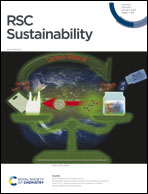Sustainability applications of rare earths from metallurgy, magnetism, catalysis, luminescence to future electrochemical pseudocapacitance energy storage
Abstract
Rare Earths (REs) are referred to as ‘industrial vitamins’ and play an indispensable role in a variety of domains. This article reviews the applications of REs in traditional metallurgy, biomedicine, magnetism, luminescence, catalysis, and energy storage, where it is surprising to discover the infinite potential of REs in electrochemical pseudocapacitive energy storage. The use of REs in the field of pseudocapacitance is an important opportunity to link resources with burgeoning electrochemical energy storage. On the basis of the electrochemical energy storage potential of REs, typical rare earth oxides are selected as research objects to provide a comprehensive overview of their research progress in the field of supercapacitors. The future challenges and opportunities that these compounds will encounter in the field of pseudocapacitance energy storage are evaluated with a summary and discussion of existing research outcomes.

- This article is part of the themed collection: Topic highlight: Sustainable materials


 Please wait while we load your content...
Please wait while we load your content...